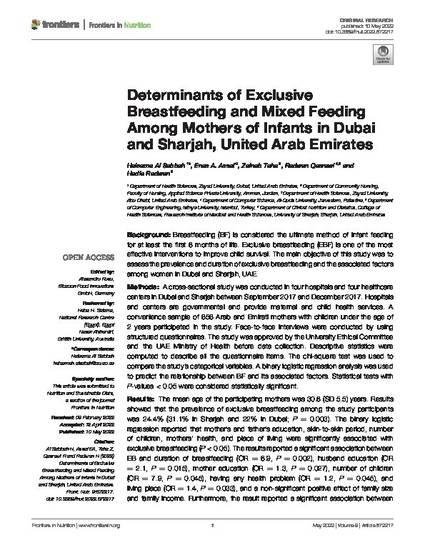
Article
Determinants of Exclusive Breastfeeding and Mixed Feeding.pdf
Frontier in Nutrition
(2022)
Abstract
Background: Breastfeeding (BF) is considered the ultimate method of infant feeding
for at least the first 6 months of life. Exclusive breastfeeding (EBF) is one of the most
effective interventions to improve child survival. The main objective of this study was to
assess the prevalence and duration of exclusive breastfeeding and the associated factors
among women in Dubai and Sharjah, UAE.
Methods: A cross-sectional study was conducted in four hospitals and four healthcare
centers in Dubai and Sharjah between September 2017 and December 2017. Hospitals
and centers are governmental and provide maternal and child health services. A
convenience sample of 858 Arab and Emirati mothers with children under the age of
2 years participated in the study. Face-to-face interviews were conducted by using
structured questionnaires. The study was approved by the University Ethical Committee
and the UAE Ministry of Health before data collection. Descriptive statistics were
computed to describe all the questionnaire items. The chi-square test was used to
compare the study’s categorical variables. A binary logistic regression analysis was used
to predict the relationship between BF and its associated factors. Statistical tests with
P-values < 0.05 were considered statistically significant.
Results: The mean age of the participating mothers was 30.6 (SD 5.5) years. Results
showed that the prevalence of exclusive breastfeeding among the study participants
was 24.4% (31.1% in Sharjah and 22% in Dubai; P = 0.003). The binary logistic
regression reported that mother’s and father’s education, skin-to-skin period, number
of children, mothers’ health, and place of living were significantly associated with
exclusive breastfeeding (P < 0.05). The results reported a significant association between
EB and duration of breastfeeding (OR = 6.9, P = 0.002), husband education (OR
= 2.1, P = 0.015), mother education (OR = 1.3, P = 0.027), number of children
(OR = 7.9, P = 0.045), having any health problem (OR = 1.2, P = 0.045), and
living place (OR = 1.4, P = 0.033), and a non-significant positive effect of family size
and family income. Furthermore, the result reported a significant association between mixed breastfeeding and duration of breastfeeding (OR = 0.1, P = 0.000), skin-to-skin
period (OR = 0.3, P = 0.002), underweight (OR = 4.7, P = 0.034), last infant’s sex
(OR = 1.6, P = 0.010), having maid at home (OR = 2.1, P = 0.000), number of children
(OR = 0.2, P = 0.013), and living place (OR =1.1, P = 0.014), and a non-significant
association with family size and family income.
Conclusions: Therefore, a health promotion program for exclusive breastfeeding during
antenatal health visits, together with initiating health policies in maternal hospitals to
encourage the initiation of breastfeeding during the first hour of birth and the introduction
of skin-to-skin contact during the first 5min of birth are highly recommended.
Keywords
- exclusive breastfeeding,
- mixed feeding,
- practices,
- Sharjah,
- Dubai,
- UAE,
- child under two years
Disciplines
Publication Date
Spring May 10, 2022
DOI
doi: 10.3389/fnut.2022.872217
Citation Information
Haleama Al Sabbah. "Determinants of Exclusive Breastfeeding and Mixed Feeding.pdf" Frontier in Nutrition (2022) Available at: http://works.bepress.com/haleama-alsabbah/40/
